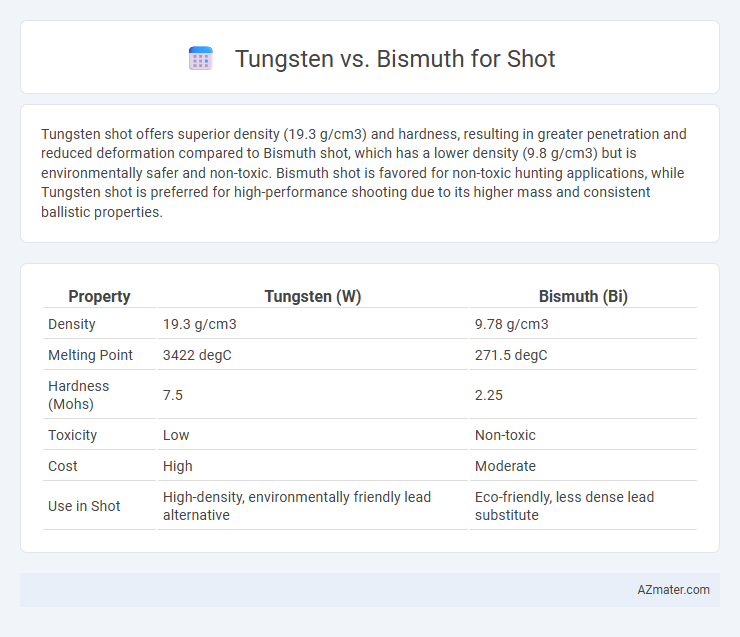Tungsten shot offers superior density (19.3 g/cm3) and hardness, resulting in greater penetration and reduced deformation compared to Bismuth shot, which has a lower density (9.8 g/cm3) but is environmentally safer and non-toxic. Bismuth shot is favored for non-toxic hunting applications, while Tungsten shot is preferred for high-performance shooting due to its higher mass and consistent ballistic properties.
Table of Comparison
| Property | Tungsten (W) | Bismuth (Bi) |
|---|---|---|
| Density | 19.3 g/cm3 | 9.78 g/cm3 |
| Melting Point | 3422 degC | 271.5 degC |
| Hardness (Mohs) | 7.5 | 2.25 |
| Toxicity | Low | Non-toxic |
| Cost | High | Moderate |
| Use in Shot | High-density, environmentally friendly lead alternative | Eco-friendly, less dense lead substitute |
Introduction to Tungsten and Bismuth Shot
Tungsten and bismuth are two prominent materials used in shot for firearms, each offering distinct advantages based on density and environmental impact. Tungsten shot is favored for its exceptional hardness, density of approximately 19.3 g/cm3, and non-toxic nature, making it highly effective for waterfowl hunting and regulated shooting environments. Bismuth shot, with a density around 9.8 g/cm3, serves as an eco-friendly alternative to traditional lead shot, providing adequate performance in corrosion resistance and reduced toxicity for wetland conservation areas.
Density Comparison: Tungsten vs Bismuth
Tungsten has a density of approximately 19.25 g/cm3, making it one of the densest metals available for shot applications, whereas bismuth has a significantly lower density of about 9.78 g/cm3. The higher density of tungsten provides greater velocity retention and deeper penetration in shotgun pellets compared to bismuth, which is nearly half as dense and offers reduced ballistic performance. This density difference is critical for hunters and shooters prioritizing weight and flight characteristics in ammunition selection.
Ballistic Performance Differences
Tungsten offers significantly higher density at 19.3 g/cm3 compared to Bismuth's 9.8 g/cm3, resulting in superior ballistic performance through greater shot energy retention and deeper penetration. Tungsten's hardness contributes to reduced deformation upon impact, maintaining shot integrity and improving accuracy over longer distances. Conversely, Bismuth provides less recoil and is environmentally friendly but sacrifices velocity and penetration power due to its lower mass and softer composition.
Lethality and Ethical Hunting
Tungsten shot exhibits superior lethality compared to bismuth due to its higher density and hardness, resulting in enhanced penetration and energy transfer upon impact. Bismuth, while less dense, offers an ethical hunting alternative as it is non-toxic and environmentally friendly, reducing the ecological footprint of shot pellets. Hunters prioritizing quick, humane kills balance tungsten's effectiveness with bismuth's sustainable benefits in ethical hunting practices.
Environmental Impact and Toxicity
Tungsten shot is favored for its lower toxicity compared to lead, posing minimal risk to wildlife and ecosystems, while bismuth shot is also non-toxic and biodegradable, making it environmentally friendly. However, tungsten mining and processing require significant energy consumption and can result in habitat disruption, whereas bismuth is often a byproduct of mining other metals, reducing its environmental footprint. Both materials offer safer alternatives to lead shot, but bismuth's biodegradability and lower ecological impact make it a preferable choice for environmentally conscious hunters.
Cost and Availability Factors
Tungsten shot is significantly more expensive than bismuth due to its higher density and limited global supply, making it a less cost-effective option for many shooters. Bismuth offers a more affordable alternative with relatively good availability, sourced primarily from byproducts of lead and copper refining. Availability of tungsten is constrained by geopolitical factors and complex extraction processes, whereas bismuth benefits from more stable production and supply chains.
Suitability for Waterfowl Hunting
Tungsten shot offers superior density at 19.3 g/cm3 compared to bismuth's 9.8 g/cm3, providing better pellet energy retention and deeper penetration, which is crucial for waterfowl hunting. Bismuth is a non-toxic alternative to lead with a similar hardness but is generally softer and less dense, resulting in reduced downrange performance and shorter effective range in waterfowl scenarios. Hunters targeting waterfowl prioritize tungsten for its outstanding ballistics and environmental safety, ensuring high lethality while complying with non-toxic shot regulations.
Choke and Barrel Compatibility
Tungsten shot offers higher density and hardness compared to bismuth, making it ideal for tighter chokes and longer barrels where pattern consistency and penetration are critical. Bismuth shot, being softer and less dense, performs well in older or more delicate barrels and more open chokes, reducing wear and maintaining barrel integrity. Selecting the appropriate shot material based on choke constriction and barrel design optimizes shot patterns and extends firearm longevity.
Reloading and Customization Options
Tungsten shot offers superior density and hardness, resulting in tighter patterns and deeper penetration, making it ideal for precision reloading and competitive shooting. Bismuth shot is softer and less dense but provides excellent versatility and is compliant with non-toxic regulations, allowing reloaders more flexibility with target and waterfowl loads. Both materials enable extensive customization in shot size, load density, and shot cup design, catering to specific hunting or shooting applications.
Final Verdict: Choosing Between Tungsten and Bismuth
Tungsten shot offers superior density and hardness, providing better penetration and tighter patterns compared to bismuth, making it ideal for waterfowl hunting. Bismuth, being softer and less dense, excels in steel shot-friendly environments and is often preferred for its non-toxic properties and affordability. The choice between tungsten and bismuth ultimately depends on specific hunting needs, shotgun compatibility, and environmental regulations, with tungsten favored for performance and bismuth for eco-friendly compliance.

Infographic: Tungsten vs Bismuth for Shot
 azmater.com
azmater.com